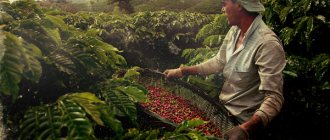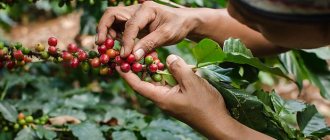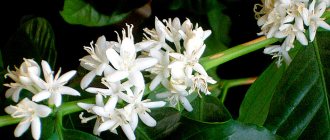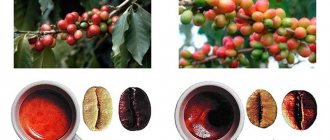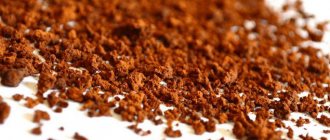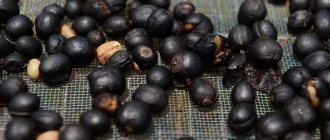Coffee Belt of the Planet
Coffee grows in 65 countries, and almost all of them supply beans to the international market.
Coffee trees are very demanding on environmental conditions - they need a very special climate. This forms the unique distribution area of the plant.
- All countries in which coffee trees can be found are located along an imaginary strip of the earth's surface that extends along the equator. This projection onto the geographic map of the Earth is called the Coffee Belt.
- The Earth's coffee belt is limited to tenths of the southern and northern latitudes. These regions are also called the Tropic of Cancer in the northern hemisphere and the Tropic of Capricorn in the southern hemisphere.
- Such an interesting habitat is not unusual. It's all about unique climatic conditions - the predominance of humid and warm weather without sharp fluctuations and frosts on the ground surface at night. A rapid drop in ambient temperature is extremely dangerous for finicky coffee trees.
- It is believed that the birthplace of coffee is Ethiopia. From there the plant began its journey around the world, but was able to take root only in regions with a similar mild equatorial climate.
Reference. The geography of coffee distribution is limited to Central Africa, South and Central America and the countries of Southeast Asia.
Where is coffee grown?
Coffee is perhaps one of the most famous hot drinks in the world. Avid coffee lovers and connoisseurs have known for a long time where coffee is grown. The territories located between the northern and southern tropics are rightly called nothing less than the coffee belt of the Earth.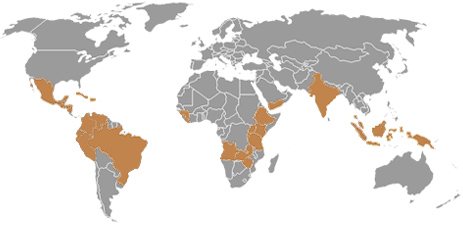
Of course, coffee can be grown at home, because Arabica beans reproduce from coffee beans. Of course, the grains should not be roasted, but fresh, well-ripened and preferably from this year’s harvest. In Russia, coffee is grown in indoor pots, but in this case the coffee tree performs an exclusively decorative function; you are unlikely to reap a full harvest from it.
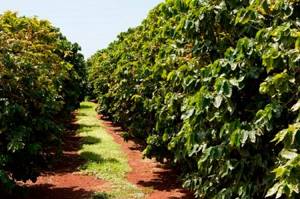
Currently, coffee is grown in eighty countries around the world. And coffee is consumed in almost every country on the globe, with the exception of wild tribes living in the abandoned wilds of the Amazon forests. In some areas of the Earth, the simultaneous combination of a tropical climate and high mountain conditions makes it possible to grow elite varieties of coffee with excellent taste characteristics.
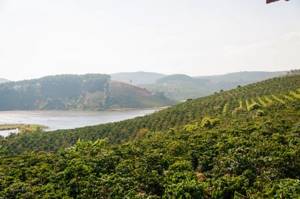
Coffee can only be grown in certain climatic conditions. Geographically, this belt is located between ten degrees south and ten degrees north latitude. The climate, natural conditions and soil in these countries are different, so the same type of coffee may differ in chemical composition, taste and bouquet. Therefore, some varieties of coffee are named after the place where they were grown. Currently, the most famous countries where coffee is grown are Colombia, Brazil and Guatemala.
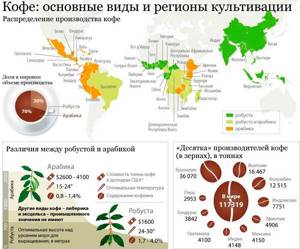
The choice, depending on where the coffee is grown, is very wide. Some people prefer to stick to a specific variety, while others like to try something new every time, discovering previously unknown facets of taste and aroma. By the way, this is a good way to arrange a kind of geographical excursion without leaving home. Each time you can try a new variety or type of coffee, combining drinking an aromatic drink with studying information about the country in which it was grown. Our online store offers a wide range of coffee from the most popular coffee-producing countries where coffee is grown.
The most popular products in the category - Coffee beans
Lavazza coffee beans Qualita Oro 1 kg 1382 rub.
| Paulig Arabica coffee beans 1 kg 676 rub. | Santo Domingo coffee beans Puro Cafe 454 g 900 rub. | Hausbrandt Espresso coffee beans 1 kg 2085 rub. | Goppion Caffe coffee beans JBM 1 kg 3265 rub. |
| Diemme coffee beans Miscela Excellent 1 kg 3504 rub. |
The most popular products in the category - Ground coffee
| Lavazza ground coffee Oro 250 g 377 rub. | Paulig Espresso Originale ground coffee 250 g 150 rub. | Dallmayr ground coffee Prodomo 250 g 350 rub. | Ground coffee Me Trang Arabica 250 g 404 rub. | Hausbrandt ground coffee Espresso 250 g 681 rub. |
| Goppion Caffe ground coffee JBM (JaBlMo) 250 g 965 rub. |
In which countries does coffee grow?
In each zone of the Coffee Belt, there are leading countries in the cultivation and export of beans.
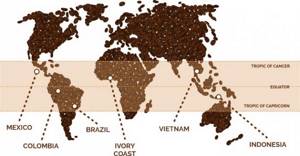
South America
Brazil. A third of the world's coffee harvest (about 40 million bags) is harvested here every year. In addition, many varieties grow here - both Arabica and Robusta. The flavor characteristics of beans from Brazil make them suitable primarily for the production of various mixtures and blends for espresso. Brazilian coffee also has a fairly affordable price.
Colombia is Brazil's eternal rival. This Latin American state cannot boast of such a huge harvest as in Brazil - about 10-13 million bags are harvested here every year. But the consumer characteristics of the beans are still much higher, since only Arabica is grown in the country. Today Colombia has 15% of the world's coffee market, offering truly high-quality varieties.
In which countries does coffee grow?
South America
Almost every third bag of coffee in the world is harvested in Brazil, which is at least forty million bags a year. It is used for mixtures and blends. Among the varieties of Brazilian coffee, mainly Arabica and Robusta. The low price is considered to be its main advantage.
Brazil's constant rival is Colombia, but it does not reach its level; it supplies the market with up to thirteen million bags of Arabica, but the quality of the product is higher. This allows it to be among the leaders in the supply of high-quality coffee, providing 15% of the world's volume.
Compared to the leaders, Peru's contribution, consisting of three to four million bags of coffee, seems more than modest. And his fame is not so wide. But single varieties, such as Chanchamayo, have quite excellent taste.
Central America
Honduras supplies about five million bags of Arabica. There are single varieties that are especially valued. For example, Madeo. But blends and mixtures are made from the bulk.
The average for Mexico is almost four million bags. Almost all of this volume is consumed by the United States. Mixtures for coffee machines - its purpose.
More than three million bags of Arabica and Robusta are supplied to the market from Guatemala. The famous Guatemalan Antigua is known to gourmets all over the world.
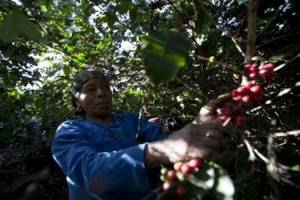
Almost half of the world's coffee bean crop is grown and supplied from South and Central America.
Asia
Asian countries are making plans to “catch up and overtake” the leaders. Moreover, the global coffee industry has long recognized the quality of many varieties ripening in the region as corresponding to the highest level.
Vietnam claims the right to join the list of world leaders. In a harvest year, the volume of supplies of Arabica and Robusta reaches thirty million bags. The country specializes in mixtures, blends and blends.
About ten million bags are supplied from Indonesia every year. This is mainly robusta; old varieties of arabica are also grown in very small quantities. Java coffee is especially popular; the Thoraya Sulawesi and Sumatra Mandeling varieties are classified as elite coffee, and Kopi Luwak is among the most expensive.
Arabica and Robusta varieties are supplied from India in a volume of more than five million bags. The coffee is a bit similar to Indonesian Robusta. It is added to mixtures. There are very special varieties, such as Malabar Monsoon, which have an unforgettable taste, and are harvested using a unique technique of aging grains on the ocean shore under the blow of the monsoon. This technology appeared here and is now successfully used by many.
Read: History of coffee
Africa
It was on this continent that coffee originated. It is far from America, but one thing is constant - the grain grown here is of consistently high quality.
The homeland of Arabica is Ethiopia, where the best coffee on the planet matures, where coffee trees have been growing on their own for hundreds of years and no one cultivates them. Six to seven million bags are its supplies.
Uganda grows mainly robusta, up to four million bags annually. It is added to various mixtures. Even though the yields here are not very high, the quality of local Arabica is very decent and even competes with Javanese varieties.
Some twenty years ago, quite recently, Côte d'Ivoire competed with Brazil and Colombia. The political situation in the country has negatively affected the volume of coffee exports. Today it is more than two million bags.
Asia
Asians are gradually starting to step on the heels of Latin American coffee producers, seriously intending to take away a significant market share from them. This is no wonder, because many high-quality varieties grow in the region.
Vietnam . This small country amazes with its harvests - 20-30 million bags are harvested here annually. In Vietnam you can find excellent varieties of Arabica and Robusta. Most of them are used for coffee mixtures and blends.
Indonesia . This island country supplies the market mainly with Robusta and only a little Arabica. The yield here is considered average - about 10 million bags. But the quality of the coffee is simply excellent. Particularly popular are varieties native to Java, Sumatra and Sulawesi. Elite types include Sumatra Mandheling (Mandheling) and Toraya Sulawesi coffee, which have an amazingly balanced taste. Indonesia is also famous for one of the most expensive types of coffee - the Kopi Luwak (Luwak) variety.
Is coffee growing in Russia?
As mentioned above, coffee beans grow only in humid and hot climates. The ideal location for a coffee plantation is approximately 25° north and 30° south of the equator.
In our country, coffee beans are not grown on an industrial scale. But amateur gardeners can grow a coffee tree on their windowsill
Basic conditions for growing
- Availability of good lighting.
- Room temperature ≥18°C.
- Acidified soil.
- Do not frequently turn the plant towards the light.
- In summer, the plant can be taken outside.
- Wintering on a southern windowsill.
- Frequent spraying and regular watering with soft water.
Africa
The origins of coffee are located on the African continent. Productivity in the region is inferior to Latin American countries, but the quality of the grain remains consistently high.
Ethiopia . In the homeland of coffee, trees have been growing naturally for many centuries. They are practically not cultivated on an industrial scale, but only harvested. The country annually produces 6-7 million bags of natural organic coffee, which is deservedly recognized as one of the best on the planet.
Uganda . The country supplies 4 million bags per year to the world market. Mainly Robusta for various coffee blends. The country also has Arabica, which is highly valued among lovers of the invigorating drink. Today, coffee from Uganda competes with popular varieties native to the island of Java.
Cote d' Ivoire . About a quarter of a century ago, this country was the main rival of Brazil and Colombia. However, political instability in the state has a negative impact on export volumes. Today, Ivory Coast supplies 2.5 million bags of coffee beans a year, including Robusta for Nescafe, the instant coffee brand of the largest corporation, Nestlé.
It is interesting to note that attempts to grow coffee are underway in Australia and New Zealand. But the predominantly flat landscape and excessive dryness in these countries are not conducive to high yields.
Leaders in coffee growing
Brazil
A state on the South American continent with an equatorial or subequatorial humid climate that is suitable for growing coffee. The average annual temperature is within 18-28°C. Precipitation amount is 1500-3000 mm per year. This allows you to maintain gardens and achieve record harvests.
Brazil produces a third of the total world volume - up to 40 million bales per year. Arabica, Robusta, Serrato, Bourbon, Bahia and Santos are grown here. Brazilian grains are of low quality - farmers are chasing quantity.
There are 800 million coffee trees in the country. In 365 days, one yields up to 3.5 kg of grains.
Main importers: USA, Italy, Japan, CIS countries led by Russia. According to experts, the state exports only 30% of the harvest. The rest goes to the domestic market. On average, each Brazilian consumes 5 kg of grains per year.
Information on the topic is in the article “Which countries occupy the first places in coffee consumption.”

Colombia
In the south of Colombia, in the Andes, high-quality Arabica beans are grown. Robusta is not found here. Manufacturers focus on quality. Colombia's market share is impressive - up to 9%, which is equal to 10 million bales. Such indicators allow the state to be one of the three largest global producers.
Interesting! Barista - who is he, what is his profession and what does he do?
Varieties: Colombia Supremo, Supremo Medellin, Excelso, Bogota. The main exports are to the USA, Germany, France, Italy and Japan.
Indonesia
A state located on the islands of the Malay Archipelago in the Pacific Ocean. Specializes in growing high quality Arabica beans.
Coffee production here was started by Europeans back in the 17th century, and the Java, Sumatra, and Sulawesi varieties are still considered elite. Indonesia produces robusta - up to 9 million bales per year.
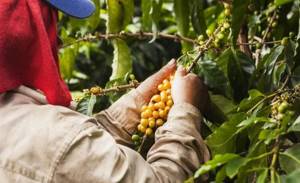
Vietnam
Coffee trees were brought to Vietnam in the second half of the 19th century and the industry did not develop until the 1980s.
At the end of the last century, Vietnam began to increase production at an accelerated pace. It has become a world leader and is currently second only to Brazil in terms of volume.
However, Vietnam is the only one that specializes in growing exclusively robusta. The Vietnamese market share is 18% of the total global volume.
Mexico
In the south of Mexico, more than 100,000 farmers cultivate Arabica varieties: Altura, Pluma, Liquidambar MS. Mexican exporters supply up to 6 million bales per year to the foreign market.
Ethiopia
The list of leaders in coffee production on the African continent is headed by Ethiopia, the birthplace of the coffee tree. Here it is possible to grow up to 4 million bales of dry grains in a good year, which is equal to 5% of the world market share.
The Sidamo variety, which is grown in the vicinity of the city of Kaffa, is rightfully considered one of the best in the world. In addition, Arabica varieties Harar and Yirgachif are produced. A quarter of the population is engaged in plantation cultivation.
India
India produces up to 3.8 million bales of premium Arabica coffee. There is an “Indian Coffee Council” in the country, which monitors the quality of the beans collected.
The technology of dry drying of raw materials gives the Indian product a delicious, unique taste. Famous varieties are Monsoon Malabar and Mysore.

Guatemala
Another American state included in the top 10 largest producers. Guatemala produces grains of the elite Huetenango and Atitlan varieties. Harvests reach 3.5 million bales per year.
Ivory Coast
At the end of the 90s, this African state received 0.9 million bales more than now. The sharp decline is associated with low-quality raw materials. To grow a lot of expensive product, planters switched to robusta. About 3.3 million bales enter the world market from Côte d'Ivoire.
Interesting! At what age can children drink coffee, its effect on the body
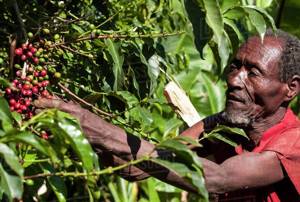
Uganda
Uganda closes the list of countries supplying grains to the world market. This small country in Africa offers robusta, although Arabica also grows there.
This is the only economic sector and almost the entire working population is employed on plantations. The average annual harvest reaches 3 million bales.
Where are most coffee beans grown?

The leaders in coffee production are only 6 countries, despite the fact that coffee trees can be found in many more countries.
- Brazil: 30%;
- Vietnam: 17%;
- Colombia: 12%;
- Ethiopia: 6%;
- Indonesia: 5%;
- India: 4%.
These countries account for 74% of global coffee exports. The rest is distributed among other countries of the Coffee Belt. Since most of the raw materials are processed into various blends, when enjoying a cup of espresso, you are most likely drinking African, Brazilian or Colombian coffee. If you are interested in the origin story, read this article.



